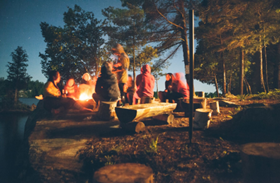Extensive sociological and Christian research show that groups of different styles and sizes are critical to the growth of the local church. Why? Because groups of different types and sizes provide the relational bridge that enable people on the fringe and outside the life of your church altogether to connect, find their place and belong. Through such groups, friendships can be formed and a sense of trust, respect and safety develop that encourage new people to join.
In this article I’ll outline the five types of groups that facilitate growth, belonging and mission. Not every church will initially be able to have all five types as some are dependent on a church’s current size. Also all five types should include the same four functions – love, learn, decide, do. (These functions were identified by Carl George and outlined in his book, Prepare Your Church for the Future.) However, the degree of focus on each function will depend on the nature of the specific group type. (I’ll highlight in parenthesis the function(s) each type needs to focus on in the examples that follow.)
The Five Types of Groups
- Core
As the name suggests, this is the smallest of the five types. Core groups consist of three to five members who meet together regularly – weekly, fortnightly, or at least monthly. If fewer than three, then the ‘group’ is really more like a partnership and is too small for the diversity of perspectives, gifts and insights needed. If larger than five, then it becomes too big for all members to participate fully and freely. Examples of core groups in a local church could be: an evangelism or mission team (love, learn, decide, do); a prayer team (love, learn, do); a support group (love, learn, perhaps do); a staff team (love, learn, decide, do); department leaders meeting (love, learn, decide); church council executive (love, learn, decide). - Cell
Groups that number between 5/6 – 12 are the most common small groups in most churches. Like the cells in the human body, these groups enable the Body of Christ to function, serve and grow. Cell groups are designed to grow numerically by division and multiplication as the ‘parent’ cell gives ‘birth’ to a new cell, supporting and releasing some members from the original cell to plant a new group. (Admittedly, many cell groups falter at this point and hence fail to birth a new cell.) The most common examples of cell groups are ‘life groups’ where members share life together, pray and usually discuss Scripture or a Christian resource such as a book or video (love, learn). Other examples of cells could be church councils (learn, decide); task groups (learn, do); contact groups – for connecting with people in the wider community, eg. play-groups, craft groups (love, learn, do); music teams (love, learn, do). - Class
These are the groups that are mainly designed for education and training. Usually between 12-25 in size, such groups tend to be relatively short term and could include New Members Classes (learn); Bible seminars (learn); skills training sessions eg. faith-sharing, leadership, leading small groups (learn, do); choirs (learn, do). - Cluster
‘Clusters’ are those larger groups, that meet regularly (usually weekly or monthly) for worship or social purposes. Most clusters average between 25–120 and are essentially sub-congregations of the local church. Examples would include ‘Messy Church’ (for young children and parents – love), youth fellowship (love, learn, do), meditative worship service (love), families’ fellowship (love, do), men’s breakfast (love, learn), ladies’ lunch outings (love, learn). Clusters often serve as a low threshold pathway for new people into the life of the church. - Celebration
Although authentic worship can, and does, occur in smaller groups and gatherings, apart from more personal intimate services, worship usually best takes place in large groups upwards of 150 in size. It’s in the large-scale gatherings that an atmosphere can be engendered encouraging participants to focus on God rather than themselves in celebration, singing and worship. Such large groups also are able to harness quality music, drama and technical resources that enhance the worship experience. Also newcomers to church are less obvious and are thus more likely to feel freer to check out a church anonymously. The Love (of God) and to learn are the primary functions of celebration type worship experiences.
What types of groups do you have in your church? What groups are missing that could help your church reach more people and grow?
If you would like to know more about how your church could develop the type of groups your church needs, feel free to contact me.



